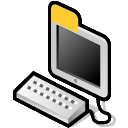Microsoft Security Newsletter - May 2014
Trustworthy Computing | May 2014
Microsoft Security Newsletter
Welcome to May’s Security Newsletter!
Our newsletter this month focuses on threat intelligence and security guidance for enterprise organizations. Earlier this month, Microsoft released its biannual cybersecurity report, the
http://www.microsoft.com/sir
Microsoft Security Intelligence Report . One of the noteworthy items to come out of the report was the threefold increase in deception tactics used to compromise systems worldwide, which is now the top threat facing enterprise environments worldwide. Taking advantage of people’s desire to get a
good deal, cybercriminals are bundling malware with free programs or software downloaded online.
One of the most common pieces of deceptive download bundles contained
malicious software that quietly abused the victim’s computer by performing clickfraud. Clickfraud makes cybercriminals money by pretending to be a person clicking on ads from your computer or by redirecting your search results.
Deceptive downloads are a problem that is global in scope. In fact, deceptive downloads were one of the top threats in 105 out of 110 countries/regions studied worldwide. In the second half of 2013, programs known to use deceptive downloads were encountered by more than 60 out of every 1,000 systems worldwide. The good news is that there are some best practices people can take to help protect against deceptive tactics:
-
Use newer software that provides enhanced protections.
-
Keep all of the software installed on your system up-to-date. This includes software from Microsoft, Adobe, Oracle, and others.
-
When downloading files or software online, make sure that you are doing so
from a trusted vendor.
-
Run up-to-date antimalware.
-
Think before you click: don’t click on links or open attachments from untrusted sources.
-
Back up your files.
Of course, these are just a few of the many key learnings from the latest. For more information on threat intelligence for your country/region, I encourage you to visit
http://www.microsoft.com/sir
http://www.microsoft.com/sir .
Best regards,
Tim Rains, Director
Microsoft
Trustworthy
Computing
Have feedback on how we can improve this newsletter? Email us at mailto:
secnlfb@microsoft.com
secnlfb@microsoft.com and share your ideas.
Top Stories
http://blogs.technet.com/b/trustworthycomputing/archive/2014/05/22/protecting- data-and-privacy-in-the-cloud.aspx
Protecting Data and Privacy in the Cloud
Learn how a privacy-inclusive approach to engineering informs how Microsoft designs, creates, and operates services by downloading the new white paper entitled,
http://download.microsoft.com/download/2/0/A/20A1529E-65CB-4266-8651-1B57B0E42D AA/Protecting-Data-and-Privacy-in-the-Cloud.pdf
Protecting Data and Privacy in the Cloud . The paper outlines MicrosoftÆs approach and processes to helping to ensure that customer data in enterprise services like Windows Azure, Office 365, Dynamics CRM Online, and Windows Intune, remains private.
http://www.microsoft.com/en-us/download/details.aspx?id=26828
Toward a Trusted Supply Chain: A Risk Based Approach to Managing Software Integrity
Explore a simple framework for the pragmatic inclusion of software integrity risk management practices in the product development process and online services operations.
http://www.microsoft.com/en-us/download/details.aspx?id=3251
Critical Infrastructure Protection Concepts and Continuum
Find out how trustworthy policies and plans, resilient operations, and innovative investments—enabled by trusted collaboration—form a continuum for protecting critical infrastructure.
http://www.microsoft.com/en-us/download/details.aspx?id=42677
Security Trends in Retail Organizations
Download a new report that identifies security trends in retail organizations and outlines key findings and recommendations around cloud computing and safe, secure practices.
Security Guidance
http://technet.microsoft.com/en-us/security/dn727114
Security Tip of the Month: Mitigate the Risk of Deceptive Downloads
Cybercriminals are perpetually trying different techniques to distribute malware and potentially unwanted software. One technique we are increasingly seeing at the Microsoft Malware Protection Center is the use of legitimate or "clean" software to deliver malicious payloads. In fact, this deceptive download tactic was one of the main drivers for an increase in malware encounter rates in the last half of 2013. The latest
LINK
Microsoft Security Intelligence Report indicates that the primary culprit was LINK
Win32/Sefnit , a Trojan family that affected worldwide malware encounter rates after its malicious files were bundled with clean software downloads.
Recently, we have seen a new twist on this deceptive tactic: previously clean applications that suddenly change their behavior and start installing malware or adware. This infection vector poses new security considerations because files that were previously determined as clean can change their behavior without warning and deliver malicious content or steal confidential information.
There are any number of reasons why clean software makes this switch to malicious behavior, but some of the more common include:
-
The software’s control/update servers are hacked (for example, by a
brute force attack against weak passwords, through the use of stolen credentials, by the actions of a rogue employee, or through other vulnerabilities).
-
The software is purchased for the purpose of delivering malicious content.
-
The software’s command and control server domains expire and are then registered by other parties.
The Filcout deception
This switch from clean to malicious behavior was first encountered in some third-party browser extensions early last year. In this case, certain popular extensions were purchased and ownership was transferred. The new extension owner would push out an update to change the functionality of the extension, thus forcing it to render advertisements or spy on the userÆs browsing activities.
More recently we have seen other software exhibiting a similar behavior. The most notable case is the addition of a new layer of deception to Sefnit with the use of the previously clean application that we detect as Win32/Filcout. Filcout is our detection for malicious software that claims to find the right program to run an unknown file type. Initially this program showed no signs of malicious behavior and gained a large installation base. At this stage, the application appeared innocuous from an enterprise security perspective.
However, in late March 2014, its behavior changed without warning. The software’s update mechanisms began responding with instructions to install Sefnit. Sefnit detections grew from 20,000 unique computer detections per day, to more than 900,000 within a two-week period as its malicious files were installed on millions of computers across the globe.
Microsoft Security Software detects and removes Sefnit, and once the
connection to Filcout was identified we began detecting and removing the application. These detections were updated for all computers protected with
our real-time security products and the stand-alone Malicious Software Removal tool (MSRT). To date the MSRT has removed Filcout from more than 9.4 million computers.
Mitigating the risk
As seen in the Filcout case, behavior changes from previously clean applications can have the potential to affect the security and confidentiality of enterprise systems. The potential risk also raises several considerations when assessing software for internal use û including the reputation of the publisher.
One of the best ways to help protect against this type of malware delivery is to take the stance that a breach might be unavoidable.
It is also advisable to record and store full packet captures according to a retention policy. Aggregated network captures should be stored for a longer duration. Together, this data is important in breach response to identify the infected computers and stolen data, and it may be used to detect future breaches by running new NIDS signatures against historical data.
Preventing the risk of a breach in the first place is still very important, and there are several recommendations that can help protect enterprise systems from attacks such as this:
-
For the major browsers, use the application-policy settings to implement an extension whitelist. This can prevent extensions from being installed into browsers unless they are on an approved list.
-
Implement a software installation policy. This policy should include a process where employees must request approval before using software on the corporate network. The approval process should evaluate the request from a security and
a legal perspective.
-
Include employee computer security training in the employee onboarding
program, and refresh it on a set timeframe.
-
Monitor and enforce corporate policy compliance.
-
Run up-to-date, real-time security software to help detect and remove malware and potentially unwanted software.
http://technet.microsoft.com/library/dn736041.aspx
Windows RT 8.1 in the Enterprise: Security
Learn how to leverage the security technologies in Windows RT 8.1, to help ensure that the devices are protected from the first time they are turned on. Explore how best to utilize smart cards, device encryption, BitLocker To Go, SmartScreen, Windows Defender, Windows Firewall, Network Access Protection and more.
http://blogs.technet.com/b/srd/archive/2014/05/13/load-library-safely.aspx
Load Libraries Safely
Dynamically loading libraries in an application can lead to vulnerabilities if not secured properly. Get advice from the MSRC Engineering team on how to load a library using LoadLibraryEx() API and make use of options to make it safe.
This Month's Security Bulletins
May 2014 Security Bulletins
Critical
-MS14-021:2965111
https://technet.microsoft.com/library/security/ms14-021
Security Update for Internet Explorer
-MS14-022:2952166
https://technet.microsoft.com/library/security/ms14-022
Vulnerabilities in Microsoft SharePoint Server Could Allow Remote Code Execution
-MS14-029:2962482
https://technet.microsoft.com/library/security/ms14-029
Security Update for Internet Explorer
Important
-MS14-023:2961037
https://technet.microsoft.com/library/security/ms14-023
Vulnerabilities in Microsoft Office Could Allow Remote Code Execution
-MS14-024:2961033
https://technet.microsoft.com/library/security/ms14-024
Vulnerability in a Microsoft Common Control Could Allow Security Feature
Bypass
-MS14-025:2962486
https://technet.microsoft.com/library/security/ms14-025
Vulnerability in Group Policy Preferences Could Allow Elevation of Privilege
-MS14-026:2958732
https://technet.microsoft.com/library/security/ms14-026
Vulnerability in .NET Framework Could Allow Elevation of Privilege
-MS14-027:2962488
https://technet.microsoft.com/library/security/ms14-027
Vulnerability in Windows Shell Handler Could Allow Elevation of Privilege
-MS14-028:2962485
https://technet.microsoft.com/library/security/ms14-028
Vulnerability in iSCSI Could Allow Denial of Service
May 2014 Security Bulletin Resources:
-
http://blogs.technet.com/b/msrc/archive/2014/05/13/the-may-2014-security-update s.aspx
Microsoft Security Response Center (MSRC) Blog Post
-
http://www.youtube.com/watch?v=LKBwbueqBKM
Security Bulletin Webcast
-
http://blogs.technet.com/b/msrc/p/may-2014-security-bulletin-q-a.aspx
Security Bulletin Webcast Q&A
Security Events and Training
https://msevents.microsoft.com/CUI/EventDetail.aspx?EventID=1032587832
BYOD: Leverage Existing Infrastructure to Secure and Manage PCs and Devices Thursday, June 5, 2014 – 12:00PM Pacific Time
Learn how to manage all your PCs and devices in a unified environment that gives you the ability to ensure that end users have the applications they need on the devices on their choice when they need them—while also enabling you to classify and further protect your data to meet compliance and security requirements.
https://msevents.microsoft.com/CUI/EventDetail.aspx?EventID=1032572980 Microsoft Webcast: Information about the June 2014 Security Bulletin Release Wednesday, June 11, 2014 – 11:00AM Pacific Time
Join this webcast for a brief overview of the technical details of June 2014’s Microsoft security bulletins. Ask questions and get answers from Microsoft security experts.
Essential Tools
-
http://technet.microsoft.com/security/bulletin
Microsoft Security Bulletins
-
http://technet.microsoft.com/security/advisory
Microsoft Security Advisories
-
http://technet.microsoft.com/solutionaccelerators/cc835245.aspx
Security Compliance Manager
-
http://www.microsoft.com/security/sdl/adopt/starterkit.aspx
Microsoft Security Development Lifecycle Starter Kit
-
http://support.microsoft.com/kb/2458544
Enhanced Mitigation Experience Toolkit
-
http://www.microsoft.com/security/pc-security/malware-removal.aspx
Malicious Software Removal Tool
-
http://technet.microsoft.com/security/cc184924.aspx
Microsoft Baseline Security Analyzer
Security Centers
-
http://technet.microsoft.com/security
Security TechCenter
-
http://msdn.microsoft.com/security
Security Developer Center
-
http://www.microsoft.com/security/msrc/default.aspx
Microsoft Security Response Center
-
http://www.microsoft.com/security/portal/
Microsoft Malware Protection Center
-
http://www.microsoft.com/privacy
Microsoft Privacy
-
http://support.microsoft.com/select/default.aspx?target=hub&c1=10750 Microsoft Security Product Solution Centers
Additional Resources
-
http://www.microsoft.com/about/twc/en/us/blogs.aspx
Trustworthy Computing Security and Privacy Blogs
-
http://www.microsoft.com/security/sir
Microsoft Security Intelligence Report
-
http://www.microsoft.com/security/sdl
Microsoft Security Development Lifecycle
-
http://technet.microsoft.com/library/cc162838.aspx
Malware Response Guide
-
http://technet.microsoft.com/security/bb980617.aspx
Security Troubleshooting and Support Resources
-
http://www.microsoft-careers.com/go/Trustworthy-Computing-Jobs/194701/ Trustworthy Computing Careers
microsoft.com/about/twcTrustworthy Computing
This is a monthly newsletter for IT professionals and
developers–bringing security news, guidance, updates, and community resources directly to your inbox. If you would like to receive less technical security news, guidance, and updates, please subscribe to the Microsoft Security for Home Computer Users Newsletter.
(c) 2014 Microsoft Corporation
http://www.microsoft.com/About/Legal/EN/US/IntellectualProperty/Copyright/defa ult.aspx
Terms of Use |
http://www.microsoft.com/About/Legal/EN/US/IntellectualProperty/Trademarks/EN- US.aspx
Trademarks
Microsoft respects your privacy. To learn more please read our online
http://go.microsoft.com/fwlink/?LinkId=248681
Privacy Statement .
If you would prefer to no longer receive this newsletter, please
http://click.email.microsoftemail.com/m_hcp.aspx?qs=0bb7f39debca1b0ad10fb2e924b 6311d344a0079e5cc587f4d16330b7c3cc8e7aa3d48879950d85d33a47e9a9586dfefd285dcac31 618dc83bcb13be2c8358eb332451395b844a857d8a8d9aa7f71fd2c12b67a36c90d95e&oneClick =newsletter
click here .
To set your contact preferences for other Microsoft communications
http://click.email.microsoftemail.com/m_hcp.aspx?qs=0bb7f39debca1b0ad10fb2e924b 6311d344a0079e5cc587f4d16330b7c3cc8e7aa3d48879950d85d33a47e9a9586dfefd285dcac31 618dc83bcb13be2c8358eb332451395b844a857d8a8d9aa7f71fd2c12b67a36c90d95e
click here .
Microsoft Corporation
One Microsoft Way
Redmond, WA 98052 USA
---
■ Synchronet ■ Time Warp of the Future BBS - Home of League 10 IBBS Games
 Web-based telnet client
Web-based telnet client Telnet
Telnet RLogin
RLogin IRC
IRC Email & news access
Email & news access